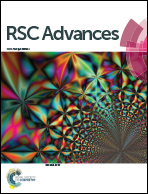Fabrication of zirconia based durable superhydrophobic–superoleophilic fabrics using non fluorinated materials for oil–water separation and water purification†
Abstract
In the present work, simple, inexpensive (without using any sophisticated equipment), durable superhydrophobic coatings on cotton fabrics with photocatalytic properties were achieved by the application of non-fluorinated hydrophobic reagents in combination with zirconia particles and subsequently AgBr modification. A hybrid mixture of hexadecyltrimethoxy silane and stearic acid was used as a hydrophobic reagent. The as-prepared coated fabrics not only displayed superhydrophobicity (water contact angle of ∼153°, water sliding angle ∼7°) and superoleophilic properties (oil contact angle of ∼0°) but also showed photocatalytic degradation of methylene blue under visible light illumination. The modified fabric can effectively separate a series of oil–water mixtures with high efficiency (>99%) even after repeated use for 10 cycles through an ordinary filtering process, without any noticeable change in efficiency. More importantly, the as-prepared coated fabric retained its superhydrophobicity and superoleophilicity under harsh environmental conditions (acidic, alkaline, salty, ultraviolet irradiation, and mechanical abrasion) and repeated tear testing with an adhesive tape. Thus, the superhydrophobic material presented in this work, with dual functionality, is a promising material for degrading organic pollutants in the water phase and in the treatment of oil spills.


 Please wait while we load your content...
Please wait while we load your content...